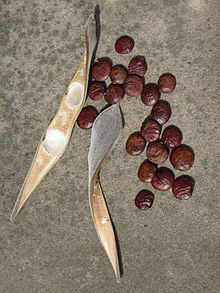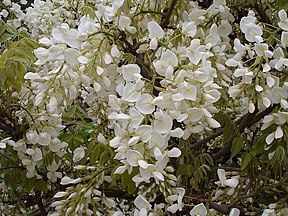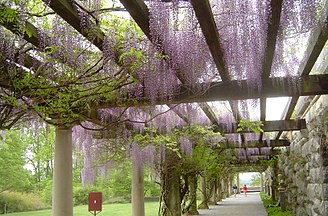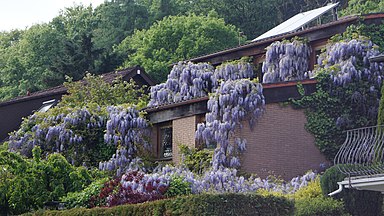Wisteria
| Wisteria | ||||||||||||
|---|---|---|---|---|---|---|---|---|---|---|---|---|

Japanese wisteria ( Wisteria floribunda ), illustration |
||||||||||||
| Systematics | ||||||||||||
|
||||||||||||
| Scientific name | ||||||||||||
| Wisteria | ||||||||||||
| Nutt. |
The wisteria ( Wisteria ) and Wisteria , wisteria , Wisteria , technical terminology also wisteria , Glycine or Glycinie called, is a plant genus in the subfamily of the Pea family (Faboideae) within the family of legumes (Fabaceae).
description
All Wisteria species are robust, vigorous, woody climbing plants ( lianas ) with twisting shoot axes. In winter only the young wood freezes back a little. Depending on the species, stature heights of over 30 meters ( Wisteria sinensis ) can be reached. Wisteria flowers mostly twice a year, with the first flowers appearing in spring before the leaves. A second, much weaker burst of flowers follows in July / August. The alternate leaves are pinnate unpaired, the leaflets have entire margins. Most small are Stipules present.
Terminal, conspicuous, large, pendulous racemose inflorescences are formed with bracts that fall off early. The hermaphrodite flowers are zygomorphic and five-fold. The five sepals are largely fused together and appear "inflated" at the base. The two upper calyx lobes are particularly short, the three lower ones are longer. The five petals are blue or white. The two wings are not fused with the shuttle. The stylus is smooth. The legumes are hard, bean-like with a velvety surface. Ripe legumes literally explode and, due to the slightly twisted torsion of the leg halves, throw their seeds often at a considerable distance. The seeds are round and flat, almost lenticular.
Toxic ingredients
Alkaloids are found in all parts of the plant . The seeds and pods mainly contain lectins (e.g. Wisteria floribunda agglutinin, WFA) and another unknown active ingredient, while the bark and roots contain wistarin , a poisonous glycoside .
Systematics and distribution
The genus Wisteria was established in 1818 by Thomas Nuttall in The Genera of North American Plants , Volume 2, pp. 115-116. The botanical genus name Wisteria honors Caspar Wistar (1761–1818). The spelling Wisteria (instead of Wistaria ) was an etymological error, but must be retained according to the rules of botanical nomenclature (International Code of Botanical Nomenclature). Synonyms of Wisteria Nutt. are: Phaseoloides Duhamel , Rehsonia Stritch.
Wisteria species are native to East Asia and eastern North America or perhaps Australia . There are four species in China, three of them only there.

There are six to ten species in the genus Wisteria :
- Wisteria brachybotrys Siebold & Zucc. : The home is Japan.
- Wisteria brevidentata Rehder (it could also belong to Wisteria sinensis ): It occurs in the Chinese provinces of Fujian and Yunnan.
- Japanese Wisteria ( Wisteria floribunda (Willd.) DC. ): Their home is Japan.
-
American Wisteria ( Wisteria frutescens (L.) Poir. ): The home is the USA. With the varieties:
- Wisteria frutescens var. Frutescens
- Wisteria frutescens var. Macrostachya Torr. & A.Gray (Syn .: Wisteria macrostachya (Torr. & A.Gray) Nutt. Ex BLRob. & Fernald )
- Chinese Wisteria ( Wisteria sinensis (Sims) Sweet , Syn .: Wisteria chinensis DC. , Wisteria praecox Hand.-Mazz. , Wisteria sinensis var. Albiflora Lem. ): The home is China.
- Wisteria venusta Rehder & EHWilson (Syn .: Wisteria brachybotrys var. Alba W.Mill. ): The home is China.
- Wisteria villosa Rehder : The home is the Chinese provinces of Anhui, Hebei, Henan, Jiangsu and Shandong.
Today in a different genre:
- Millettia japonica (Siebold & Zucc.) A. Gray (Syn .: Wisteria japonica Siebold & Zucc. )
use
Wisteria coals become the greening of pergolas used and house walls. Wisteria grow very quickly in a sunny location and in water-permeable soil and tend to overgrow trellises with their main shoots . Solidly anchored, sturdy trellises are to be preferred, which can still bear the weight of the wisteria even years later. The stability of scaffolding that is attached directly to the house wall should be checked annually. The connections of simple trellises can be pushed apart by the massive, looping shoot axes of the plant. As long as the runners of the plant still have a firm hold on top, this is harmless, since the frame parts are held in their position by the loop drives and form a stable bond with them.
With its vigor, wisteria is able to move roof tiles, constrict rainpipes, bend balusters and loosen climbing ropes from their anchoring by wrapping them around them. Since Wisteria varieties can tear off even massive mounts of climbing ropes over the years, it is advisable to unwind the young leading shoot from the rope at the end of the growing season and then tie it to it in a straight line. Alternatively, sticks can be used instead of climbing ropes. Façade parts that should not be overgrown should be kept a distance of 1.5 meters.
In the Japanese Iya Valley ( Tokushima Prefecture ) bridges were built from the thick spiral shoots of the Japanese Wisteria ( Wisteria floribunda ) to cross rivers . To do this, the lianas were braided together after they had reached a sufficient length, and wooden planks were added.
photos
Wisteria varieties:
The largest wisteria in the world in Sierra Madre, California . This Chinese wisteria was planted around 1890 and covers 4000 m².
literature
- Syed Irtifaq Ali: Wisteria at Tropicos.org. In: Flora of Pakistan . Missouri Botanical Garden, St. Louis
- Zhi Wei, Les Pedley: Wisteria , p. 188 - the same text online as the printed work , In: Wu Zheng-yi, Peter H. Raven, Deyuan Hong (ed.): Flora of China. Volume 10: Fabaceae. , Science Press and Missouri Botanical Garden Press, Beijing and St. Louis, 2010. ISBN 978-1-930723-91-7 (Systematics and Distribution Sections)
Web links
Individual evidence
- ↑ Wisteria sinensis at giftpflanze.com .
- ^ Wisteria at Tropicos.org. Missouri Botanical Garden, St. Louis, accessed July 16, 2014.
- ↑ a b c d e f g data sheet at International Legume Database Information Service = ILDIS - LegumeWeb - World Database of Legumes , Version 10.38 from July 20, 2010.
- ↑ Wisteria on facades, growth and cut at fassadengruen.de
- ↑ The Vine Bridges of Iya Valley , Atlas Obscura; Accessed: January 12, 2013 (English)










